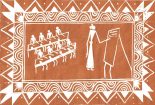Bonda (Remo) language is spoken mainly in the Malkangiri district of the Odisha state. The study of Bonda is accompanied with significant difficulties for researchers due to the inaccessibility and insecurity of the region. The number of Bonda speakers does not exceed 10 thousand people, and this language, therefore, is not displayed in the Census of India. According to the Ethnologue data (provided with the reference to SIL International 2002) the number of Bonda speakers is 9 thousand.
Another common name for Bonda language and people is Remo, which means ‘man’ in this language. While the Malkangiri district is not allowed for visiting by foreigners, it is possible to meet Bonda in the Koraput district – in boarding schools, hospitals or at tribal fairs. Bonda women can be easily recognized at the fair by their bright beaded headdresses and decorated chest necklaces.
Bonda language has two dialects named Hill and Plain Bonda. Plain Bonda people is more culturally assimilated by the Indo-Aryan and Dravidian environment. There are more borrowings in their language, bilingualism is widespread among them, and many of them are losing their language. The Hill Bonda dialect has been studied much less than the Plain one due to its inaccessibility for researchers.
Considering the rapid changes in the region, the position of Bonda language is vulnerable. It needs support arrangements. One of such arrangements is the MultiLingual Education program. This is an official governmental program for introducing minor native languages into the elementary school as a language of instruction. Currently, such teaching is conducted in several schools in the villages where Bonda is spoken. The state school textbooks from first to fourth grade are published in Bonda, using an Oriya-based writing system. A significant participation in this MLE program is taken by the Asha Kiran Society.

